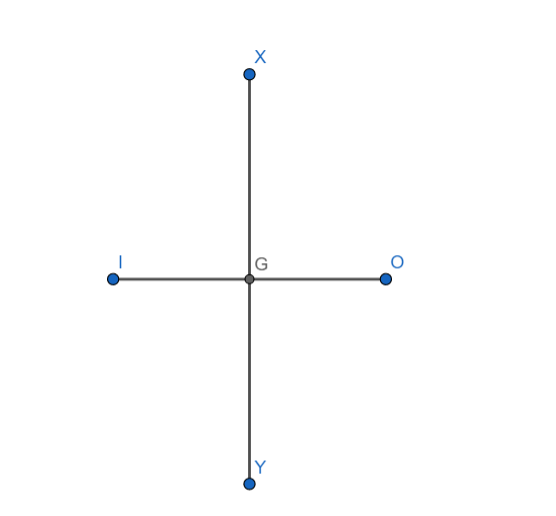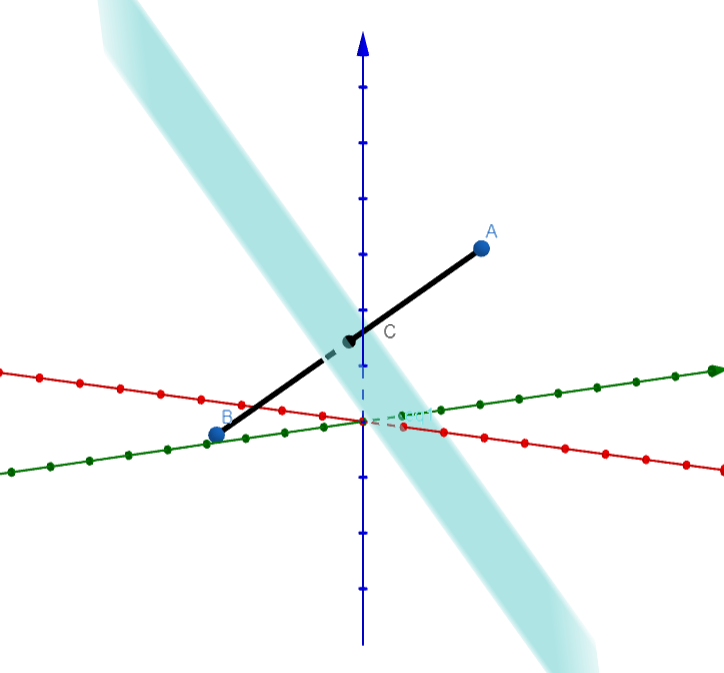Question
Question: The mirror image of the point (1,2,3) in a plane is \(\left( \dfrac{-7}{3},\dfrac{-4}{3},\dfrac{-1}{...
The mirror image of the point (1,2,3) in a plane is (3−7,3−4,3−1). Which of the following points lies on the plane?
[a] (-1,-1,1)
[b] (1,1,1)
[c] (1,-1,1)
[d] (-1,-1,-1)
Solution
Hint: Use the fact that the midpoint of the line joining the object with the image lies on the plane. Hence find the coordinates of a point on the plane. Use the fact that the line joining the image with the object is normal to the plane. Hence find the normal vector of the plane. Now, use the fact that any line in the plane is perpendicular to the normal vector of the plane. Hence find which of the options lies on the plane.
Complete step by step solution:

Consider a plane mirror XY. Let O be the object and let I be the image of the object O in the mirror XY. The following two properties are satisfied:
[1] IO is perpendicular to XY
[2] G is the midpoint of IO.

Hence, we have C is the midpoint of A(1,2,3) and B(3−7,3−4,3−1)
Hence by midpoint theorem, we have
C≡21−37,22−34,23−31=(3−2,31,34)
Also, we have AB is perpendicular to the plane mirror.
Now, we have
AB=Pv(B)−Pv(A)=3−7i−34j−31k−i−2j−3k=3−10i−310j−310k
We know that if v is normal to a plane P, then nv is also normal to the plane P, where n is any scalar.
Since AB is normal to the plane mirror, we have
10−3AB is also normal to the plane mirror
Hence, we have
i+j+k is also normal to the plane mirror.
We know that the equation of a plane, whose normal is n=ai+bj+ck and passes through A(x0,y0,zo) is given by
a(x−x0)+b(y−y0)+c(z−z0)=0
Since i+j+k is normal to the plane mirror and the plane passes through C(3−2,31,34), we have
1(x+32)+1(y−31)+1(z−34)=0⇒x+y+z−1=0
which is the required equation of the plane mirror.
Now, we check option wise which of the options satisfies the equation of the mirror.
Option [a]:
We have x = -1, y = - 1 and x = 1
Hence, we have
x+y+z-1 = -1-1+1-1 = -2.
Hence option [a] does not lie on the mirror
Option [b]:
We have x = 1, y = 1 and z =1
Hence, we have
x+y+z-1 = 1+1+1-1 = 2
Hence option [b] does not lie on the mirror
Option [c]:
We have x = 1, y = -1 and z =1
Hence, we have
x+y+z-1 = 1-1+1-1 = 0
Hence option [c] lies on the mirror
Option [d]:
We have x = -1, y = -1 and z =-1
Hence, we have
x+y+z-1 = -1-1-1-1 = -4
Hence option [d] does not lies on the mirror
Hence option [c] is the only correct answer.
Note: Alternatively, we can use the vector equation of the plane to verify which of the points lie on the plane.
Let r be the position vector of any point P on the plane.
Since CPis perpendicular to the normal, we have
CP.(i+j+k)=0
Now, we know that
CP=Pv(P)−Pv(C)
Hence, we have
CP=r−(3−2i+31j+34k)
Hence, we have
(r−(3−2i+31j+34k))⋅(i+j+k)=0, which is the required equation of the plane.
Check which of the options [a], [b], [c] and [d] satisfies the equation and hence find the answer.
